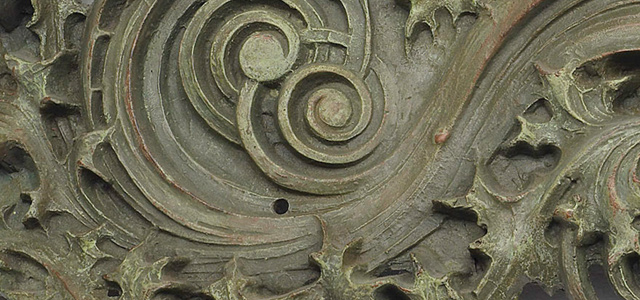Looking After Louis Sullivan
By Laura M. Browning in Arts & Entertainment on Jul 20, 2010 5:20PM

Louis H. Sullivan. Gage Building: Horizontal Ornament from the Facade (detail), 1898-1899. Gift of Mr. and Mrs. L. Lattin Smith.
The Art Institute has relegated a gem of an exhibit to the basement, sandwiched between offices and long, dim hallways, but Looking After Louis Sullivan: Photographs, Drawings, and Fragments is worth leaving the airy Modern Wing for. It features the work of three photographers—John Szarkowski, Richard Nickel, and Aaron Siskind—who documented Louis Sullivan’s architecture in the 1950s, three decades after Sullivan died in near obscurity.
The exhibit is organized by photographer, making it easy to see how Nickel’s close studies of geometry and form contrast to Szarkowksi’s more epic views. Of course, the architecture itself is stunning no matter how you look at it, filled with Sullivan’s trademark ornamentation that you might recognize from some of your favorite Chicago buildings, and that famously influenced Frank Lloyd Wright. The exhibit includes several pieces of that ornamentation, including part of an elevator grille enclosure and façade ornaments from the Gage Building and Getty Tomb, both in Chicago.
Nickel discovered Sullivan under the tutelage of Aaron Siskind, his teacher at Chicago’s Institute of Design, who instructed his students to go out and photograph Sullivan’s architecture in the late 1950s. This unfortunately coincided with widespread building demolitions under the guise of “urban renewal,” and Nickel’s photographs and salvaged ornaments are some of the best remaining pieces of Sullivan buildings like the Chicago Stock Exchange and several area theaters. Some of Nickel’s photographs included in Looking After Louis Sullivan document the heartbreaking demolition of Chicago’s Garrick Theater in 1960, the massive interior arch ripped of its décor, the floors replaced by bulldozers and piles of dirt.
Together, the three photographers’ works are an excellent primer for those uninitiated to Sullivan’s architecture, and will give Sullivan enthusiasts plenty to salivate about. Though it’s said that architecture is frozen music, these gorgeous black-and-white prints begin to thaw the melodies of Sullivan’s functional, ornamental style. Louis Sullivan tried to establish a distinctly American style of architecture and championed the idea that “form ever follows function,” and though he was destitute and forgotten when he died, he has since enjoyed a resurgence of appreciation. The Art Institute has curated a compact exhibit that reveals depths about the work of a man who is both iconic to Chicago and whose radical architectural ideas influenced a nation.
Looking After Louis Sullivan is at The Art Institute of Chicago, 111 S. Michigan Ave, until December 12, 2010. Admission is $18 for adults and is free on Thursdays from 5 p.m. - 8 p.m. The exhibit is presented in concert with the Chicago Cultural Center’s Louis Sullivan’s Idea.